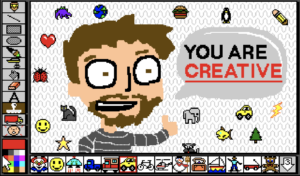 “I’m not creative” is one of the biggest lies I’ve ever heard. This far too common phrase is often announced by individuals who restrain themselves from unleashing their true imaginative talents. It’s not their fault that they believe they lack creativity, but more so the fault of a culture that influences people to constantly weigh their own abilities against others. Truthfully, we all have creativity in our bones; We just need to find outlets to express it.
“I’m not creative” is one of the biggest lies I’ve ever heard. This far too common phrase is often announced by individuals who restrain themselves from unleashing their true imaginative talents. It’s not their fault that they believe they lack creativity, but more so the fault of a culture that influences people to constantly weigh their own abilities against others. Truthfully, we all have creativity in our bones; We just need to find outlets to express it.
Take a step back to kindergarten. At some point in everyone’s life, we’re given creative tools and told to create. Your teacher hands you a paint brush and some cheap acrylics and you begin to stroke all over a page. Who’s to say you can’t pick back up a brush and start again.
My Dive into Creativity
Being a millennial born in the early 90s, I feel that I was destined to work heavily in the digital art space due to the increasing accessibility to computer technology that boomed during my childhood. Since it’s all the rage to discuss nostalgia, particularly using it as bait to gain readership, I’d like to take a dive into one of my fondest memories of discovering my creative side.
Some of my favorite moments of early elementary school were in our library computer lab. Each of us were sat at one of Apple’s bright, candy-colored iMac G3s. We were given free reign over a variety of educational software and for me, I found some of my original creative inspiration through the classic children’s computer software, Kid Pix. This tool allowed kids in the 90s to experience digital art for the first time ever with many dazzling features. It introduced the idea of brushes of varying sizes, color swatches, pixels, patterns and so much more.
As an adult, I feel that there is a lot to learn from Kid Pix. What strikes me the most about the original 1991 release of this software is that it never holds your hand, but instead flings you headfirst into the action of being creative. Never does it give you a tutorial nor does it explain how buttons function. Instead, your task is to click the icons and discover the results. The software even encourages exploration of the tools without studying them first. It’s a primitive paint program that knows exactly what it needs to do, which is to make the user feel empowered to play without consequence.
“And don’t worry. You can’t get in trouble or make a mistake, because with Kid Pix there are no mistakes to be made!” states the software’s Help notes. This note can apply to all sorts of creative exploration. By relinquishing any fears of judgement, you can discover uniqueness in your style.
Generating Your Creative Spark
Being creative does not necessarily mean you need to physically paint a picture. Creativity applies to any form of critical thinking, problem solving and ideation. It is very easy to get yourself caught up in sticking to tried and true methods, but the real challenge comes from thinking outside the box. Here at Sweeney, we pride ourselves in being a full-service agency that provides unique and creative solutions for our clients.
Here are a few ways I get myself in a creative mindset.
Sketches, Notes and Other Visual Ramblings
When I head into a project looking for a creative solution, I thrive by rattling out spontaneous ideas on a page. Doodling vague images, jotting down words for inspiration and even collecting related images for a mood board helps get those creative juices flowing. By getting ideas out of your head into the physical world, you avoid potentially forgetting concepts that can get you off running.
Listen to Music
One of the most inspiring tools I use while working is music. I like to think of it as creating a soundtrack to my project, similarly to how one would plan out scoring a film. In letting your mind drift into background music, your imagination becomes free to wander as you invent new thoughts and solutions.
Find Emotion in your Process
Some ways I bolster my imagination is to approach a project keeping different moods in mind. Depending on what I’m going for, different emotions can lead to different results. If you had a bad day, your creative solutions may be darker, more pessimistic. If you find excitement, your work may be brighter, more dynamic. Pablo Picasso’s Blue Period is one of my favorite periods of his work; work that was heavily influenced by depression and his dramatic surroundings. This is not to say you need to be depressed when working (especially like Picasso), but these emotional lenses are clearly great catalysts for interesting work.
Remove Comparisons to Others
It is totally ok to be inspired by the work of others, but as soon as you begin to criticize yourself for not being as talented as your inspirations, you begin to limit your creative potential. I recommend shutting down your negative thoughts as quickly as possible, which I know can be struggle in itself. By ignoring fears of judgement, you open the door to far more creative possibilities than you may expect.
Recently it came to my attention that Kid Pix Version 1.0 is currently available via Archive.org and can be emulated through a browser. I challenge you to create art as I did as a child with these now retro tools.
“There are no mistakes, just happy accidents.” ― Bob Ross


